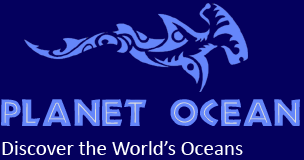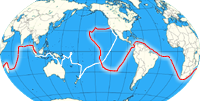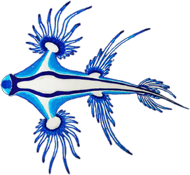After 7 days of sailing, including a stop to clean our hull once more, so we won't introduce alien organisms and the officials won't send us out again 40 miles to do a proper job, we reach the first island within the Galapagos Archipelago. The night before we arrived we heard some funny clicking noises around the boat and we noticed a bird flying circling us. It was a Swallow-tailed Gull (Larus furcatus), the only gull in the world hunting by night with special clicking noises. It probably is a sort of echolocation to spot small fish and squid where bioluminescens (emitting light) could help them.
The first part of the island we see after sunrise is Punta Pitt, where we are greeted by many endemic sea birds as well as jumping Mobula rays and mating Galapagos Green Turtles (Chelonia mydas agassisi). That is the way we like it!
Punta Pitt is situated at the northern tip of San Cristobal and the bay looks inviting to anchor and stay a bit. Sadly the anchoring of private vessels is only allowed in three areas close to the three main towns. Only tour boats with a guide are allowed to anchor on other places. But we knew that in advance and so we decided to sail along the western coast of the island to get a first impression.
After arriving in Puerto Baquerizo Moreno, the capital of Galapagos, our boat is inspected. The hull is checked by a snorkeler and the boat is checked for live insects and plants. Everything is okay. The only thing now is to get Pakia tea fumigated, so also the hidden insects get killed.
Directly in town there is a large colony of Galapagos Sea lions (Zalophus wollebaeki) which you can find everywhere, lazily lying around. They lie on the docks, many benches, boats, which are not barricaded enough, and even jump into dinghys. So we prefer to keep our dinghy on deck and use the water taxi boats to get into town.
The beach in the middle of the town is their territory where one can observe them preferably in the mornings and evenings. You get really close and can see the so called beach master or bull – the name for the big male leader of the group – watching over his “harem” of females in the coastal and water zone. He has a lot to do since other male sea lions come onto his beach. But he is still able to drive them away to go back to sleep in the next moment. The young pups are especially sweet and love to play in shallow water and have to wait for their mothers to get some milk during the day. All the time the are hunting for the small fish which gather around our boat. Also at night, when they sometimes make a lot of loud and funny noises. During our trips we have many opportunities to snorkel and swim with them. A really special experience!
Next to the Galapagos Sea lions on the dock you also see Marine Iguanas (Amblyrhynchus cristatus). There are at least 7 subspecies which have a different coloration and size, depending on which island you are on. They are endangered by feral cats, dogs and rats which lead to dropping numbers. Only in the Galapagos Archipelago, Marine Iguanas have evolved, probably due to a lack of food on land. Most of the time they still live on land where they also have their nests, but for feeding they go into the ocean. Their main food source are marine algae and they are able to hold their breath for 10 min. (big ones even up to 30 min.) and dive down to a depth of 15 meters. Because they are ectothermic, or cold-blooded, they can only stay in the water for a short period of time and have to heat up in the sun afterwards. Helpful is the dark gray to almost black coloring, with renders them almost invisible on the lava rocks. Especially the male Iguanas during their mating period can have other colors, like reddish (San Cristobal) or greenish. At Loberia beach we still find many big specimen although the population here has become rather small. For us they really look like little dinosaurs and we hope to see them feeding under water at some point.
Behind the National Park Interpretation Center on the west side of town the trail towards Tijeretas or Frigate Bird Hill starts. For the first time we see some of the cacti which can grow so large that they look like trees. It is the endemic Candelabra Cactus (Jasminocereus thouarsii var thouarsii) which can reach a height of 7 to 8 meters. And we encounter some of the 13 species of “Darwin finches” (one more lives on Isla Cocos to the north of the Galapagos Archipelago – the Cocos finch). The actual birds are rather inconspicious, small and mostly colored black or brown, but for Darwin they were the inspiration for his famous theory of evolution. When he visited the islands in 1835 he collected all animals and plants he encountered to examine and catalogue them later in England. But he neglected to label the birds and tortoises correctly because he thought they are the same on all of the islands. Lucky for him also the captain of the Beagle, Fitzroy, and his assistant Simms Covington collected the birds and tortoises and labeled them correctly. So Darwin was able to see the similarities and differences of the finches on different islands, as well as the similarities to a species found in Central America. Meanwhile, through DNA testing, the scientists were able to identify a common ancestor. Every species of the finches on the islands of Galapagos developed due to their isolation and lack of enemies, and would fit in its own particular ecological niche.
Next to the Medium (Geospiza fortis) and Small Ground Finch (Geospiza fuliginosa) we also saw the Vegetarian Finch (Camarhynchus crassiroatris). Furthermore we saw some distinctly colored Yellow Warblers (Dendroica petechia aureola) which can be found on all islands, as well as the Galapagos Flycatcher (Myriarchus magnirostris). On our way to Tijeretas we also found some endemic Galapagos Blue Butterfly (Leptodes parrhasioides) and in the bay of Tijeretas we were able to snorkel with some Galapagos Sea lions as well as look under water for the first time. At the moment the water is warm and has a temperatur of 25°C due to the warm Panama current.
A trip across the southern part of the island brings us the the only substantial fresh water lake, El Junco, basically a small crater filled with water. There we see our first Miconia shrubs (Miconia robinsoniana) as well as many Galapagos Carpenter Bees (Xylocopa darwini), where the females are black but the males have an orange-brown color. We enjoy the view across the northern part of the island towards Punta Pitt. Then we visit the Galapagoeras, the tortoise breeding station on San Cristobal. Here we are able to see our first Galapagos Giant Tortoises (Chelonoidis chatamensis) in a fenced area. With the help of the breeding center, where the eggs are collected and the young tortoises are kept, they want to reintroduce those tortoises to the southern part of the island where they vanished. In the north of the island approximately 1.800 individuals are left in the wild but were also decimated because of introduced animals like feral dogs, which eat young tortoises, or feral goats, which eat all their food and cause soil erosion. At the age of five years the young tortoises are released into the wild because at this age there are not so vulnerable anymore and can survive on their own. The tortoises can be divided into two groups depending on the shape of their shells, saddleback and dome-shaped. The species on San Cristobal belongs to the saddleback group, which means they can reach higher up into the vegeation. “Galapago” is an old Spanish word for “saddle”. We stay two weeks in San Cristobal then leave for the next port of Puerto Ayora on the island of Santa Cruz. We are looking forward to all the things to explore and see there.



_at_Punta_Pitt.jpg)
_which_is_the_only_night-feeding_gull_in_the_world.jpg)
.jpg)
_flying_at_Punta_Pitt.jpg)




_taking_a_nap.jpg)






.jpg)
.jpg)
_right_at_the_pier_in_Baquerizo_Moreno.jpg)




.jpg)

_warming_up_in_the_sun.jpg)




.jpg)
.jpg)
.jpg)
.jpg)
_at Tijeretas.jpg)
.jpg)
.jpg)
_flying_at_Tijeretas.jpg)





_with_his_breeding_pouch.jpg)
_the_saddleback_tortoises_of_San_Cristobal_in_the_breeding_center.jpg)



_which_is_dangerous_for_humans_can_be_eaten_by_tortoises.jpg)


 >>planned route - join us ...
>>planned route - join us ...